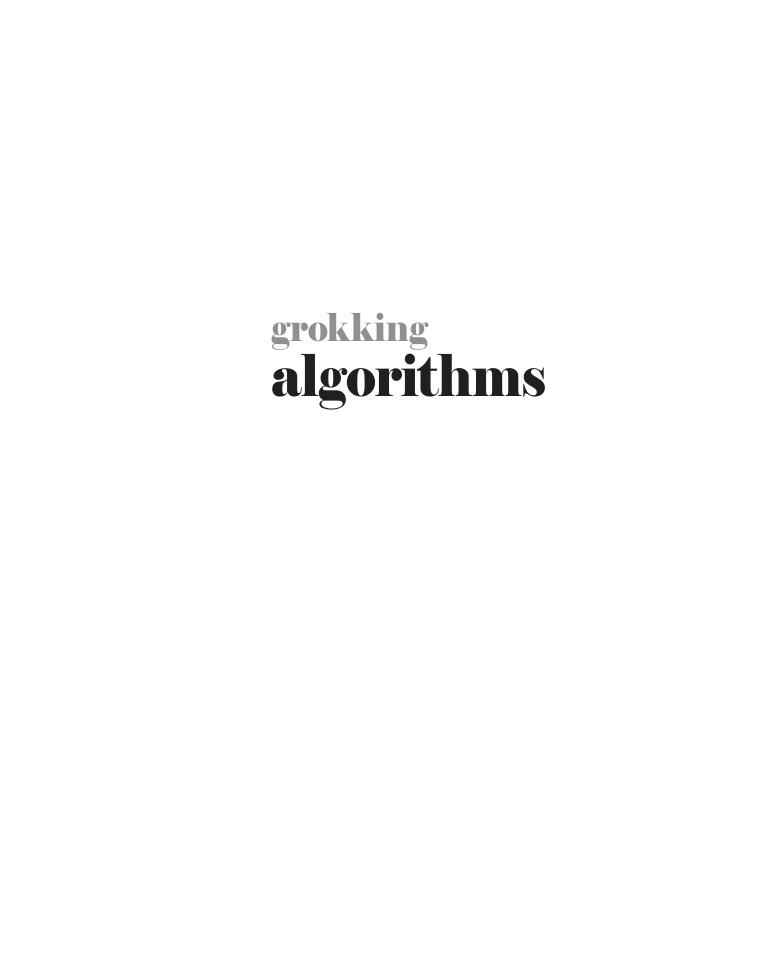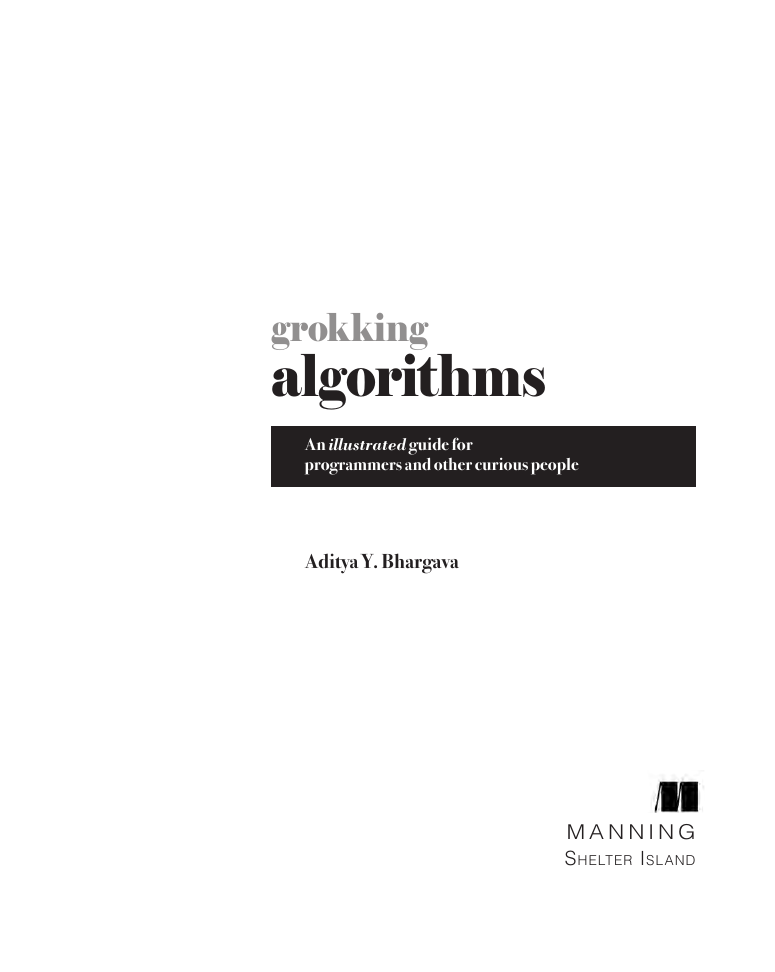Cover
contents
preface
acknowledgments
about this book
Chapter 1 Introduction to Algorithms
Introduction
What you’ll learn about performance
What you’ll learn about solving problems
Binary search
A better way to search
Running time
Big O notation
Algorithm running times grow at different rates
Visualizing different Big O run times
Big O establishes a worst-case run time
Some common Big O run times
The traveling salesperson
Recap
Chapter 2 Selection Sort
How memory works
Arrays and linked lists
Linked lists
Arrays
Terminology
Inserting into the middle of a list
Deletions
Selection sort
Recap
Chapter 3 Recursion
Recursion
Base case and recursive case
The stack
The call stack
The call stack with recursion
Recap
Chapter 4 Quicksort
Divide & conquer
Quicksort
Big O notation revisited
Merge sort vs. quicksort
Average case vs. worst case
Recap
Chapter 5 Hash Tables
Hash functions
Use cases
Using hash tables for lookups
Preventing duplicate entries
Using hash tables as a cache
Recap
Collisions
Performance
Load factor
A good hash function
Recap
Chapter 6 Breadth-First Search
Introduction to graphs
What is a graph?
Breadth-first search
Finding the shortest path
Queues
Implementing the graph
Implementing the algorithm
Running time
Recap
Chapter 7 Dijkstra’s Algorithm
Working with Dijkstra’s algorithm
Terminology
Trading for a piano
Negative-weight edges
Implementation
Recap
Chapter 8 Greedy Algorithms
The classroom scheduling problem
The knapsack problem
The set-covering problem
Approximation algorithms
NP-complete problems
Traveling salesperson, step by step
How do you tell if a problem is NP-complete?
Recap
Chapter 9 Dynamic Programming
The knapsack problem
The simple solution
Dynamic programming
Knapsack problem FAQ
What happens if you add an item?
What happens if you change the order of the rows?
Can you fill in the grid column-wise insteadof row-wise?
What happens if you add a smaller item?
Can you steal fractions of an item?
Optimizing your travel itinerary
Handling items that depend on each other
Is it possible that the solution will requiremore than two sub-knapsacks?
Is it possible that the best solution doesn’tfill the knapsack completely?
Longest common substring
Making the grid
Filling in the grid
The solution
Longest common subsequence
Longest common subsequence—solution
Recap
Chapter 10 K-nearestneighbors
Classifying oranges vs. grapefruit
Building a recommendations system
Feature extraction
Regression
Picking good features
Introduction to machine learning
OCR
Building a spam filter
Predicting the stock market
Recap
Chapter 11 Where to Go Next
Trees
Inverted indexes
The Fourier transform
Parallel algorithms
MapReduce
Why are distributed algorithms usefule?
The map function
The reduce function
Bloom filters and HyperLogLog
Bloom filters
HyperLogLog
The SHA algorithms
Comparing files
Checking passwords
Locality-sensitive hashing
Diffie-Hellman key exchange
Linear programming
Epilogue
Answers to Exercises
CHAPTER 1
CHAPTER 2
CHAPTER 3
CHAPTER 4
CHAPTER 5
CHAPTER 6
CHAPTER 7
CHAPTER 8
CHAPTER 9
CHPATER 10
Index
A
B
C
D
E
F
G
H
I
J
K
L
M
N
O
P
Q
R
S
T
U
W
















 2023年江西萍乡中考道德与法治真题及答案.doc
2023年江西萍乡中考道德与法治真题及答案.doc 2012年重庆南川中考生物真题及答案.doc
2012年重庆南川中考生物真题及答案.doc 2013年江西师范大学地理学综合及文艺理论基础考研真题.doc
2013年江西师范大学地理学综合及文艺理论基础考研真题.doc 2020年四川甘孜小升初语文真题及答案I卷.doc
2020年四川甘孜小升初语文真题及答案I卷.doc 2020年注册岩土工程师专业基础考试真题及答案.doc
2020年注册岩土工程师专业基础考试真题及答案.doc 2023-2024学年福建省厦门市九年级上学期数学月考试题及答案.doc
2023-2024学年福建省厦门市九年级上学期数学月考试题及答案.doc 2021-2022学年辽宁省沈阳市大东区九年级上学期语文期末试题及答案.doc
2021-2022学年辽宁省沈阳市大东区九年级上学期语文期末试题及答案.doc 2022-2023学年北京东城区初三第一学期物理期末试卷及答案.doc
2022-2023学年北京东城区初三第一学期物理期末试卷及答案.doc 2018上半年江西教师资格初中地理学科知识与教学能力真题及答案.doc
2018上半年江西教师资格初中地理学科知识与教学能力真题及答案.doc 2012年河北国家公务员申论考试真题及答案-省级.doc
2012年河北国家公务员申论考试真题及答案-省级.doc 2020-2021学年江苏省扬州市江都区邵樊片九年级上学期数学第一次质量检测试题及答案.doc
2020-2021学年江苏省扬州市江都区邵樊片九年级上学期数学第一次质量检测试题及答案.doc 2022下半年黑龙江教师资格证中学综合素质真题及答案.doc
2022下半年黑龙江教师资格证中学综合素质真题及答案.doc